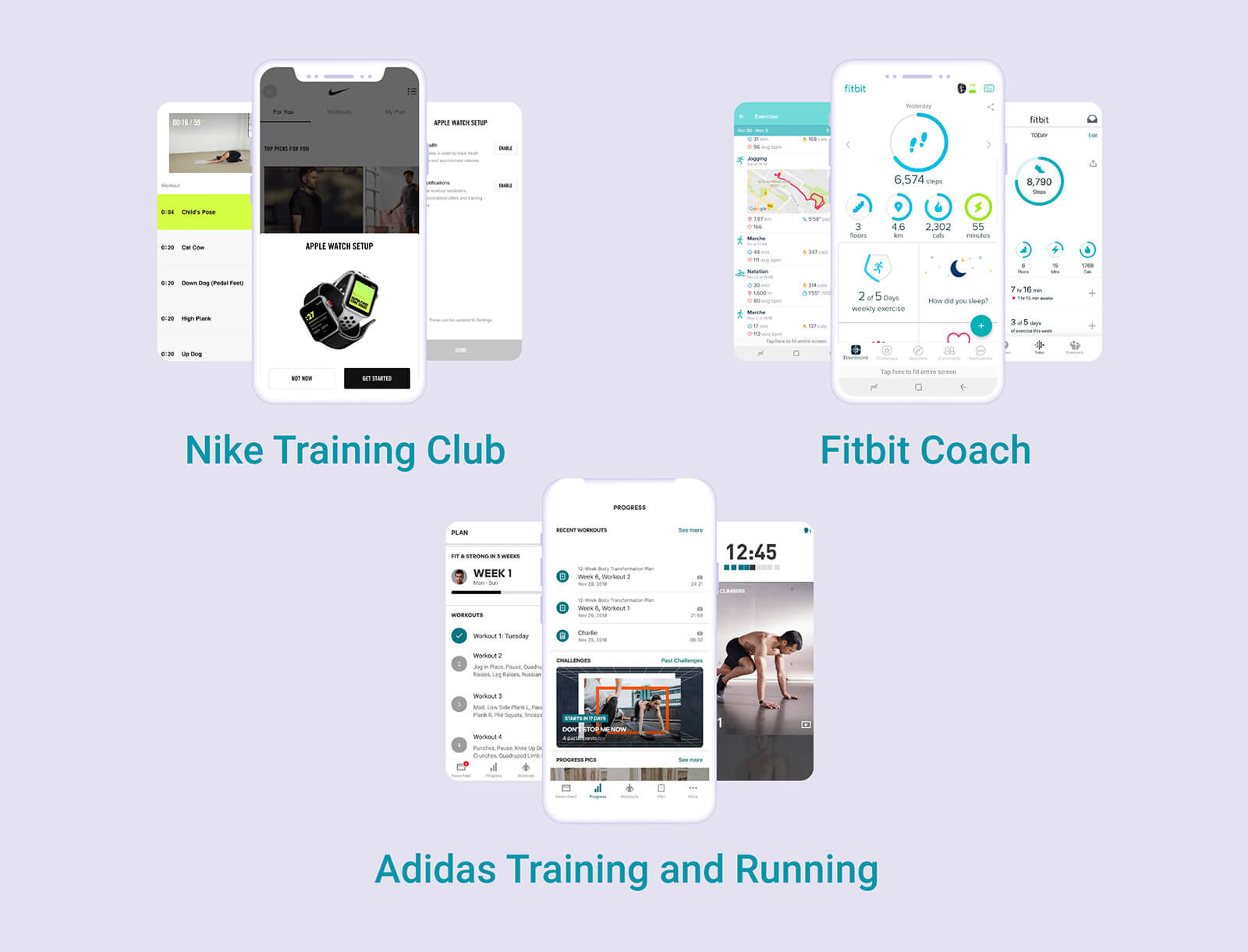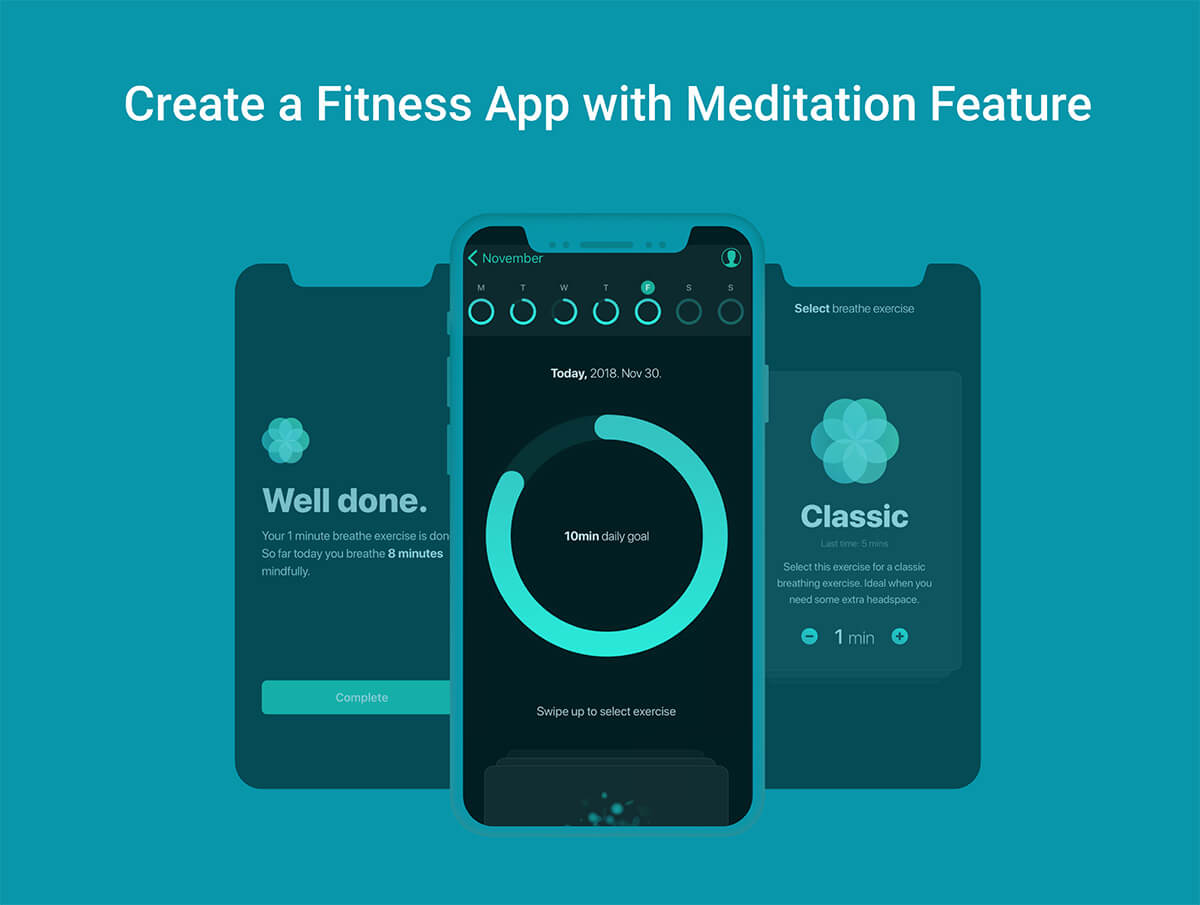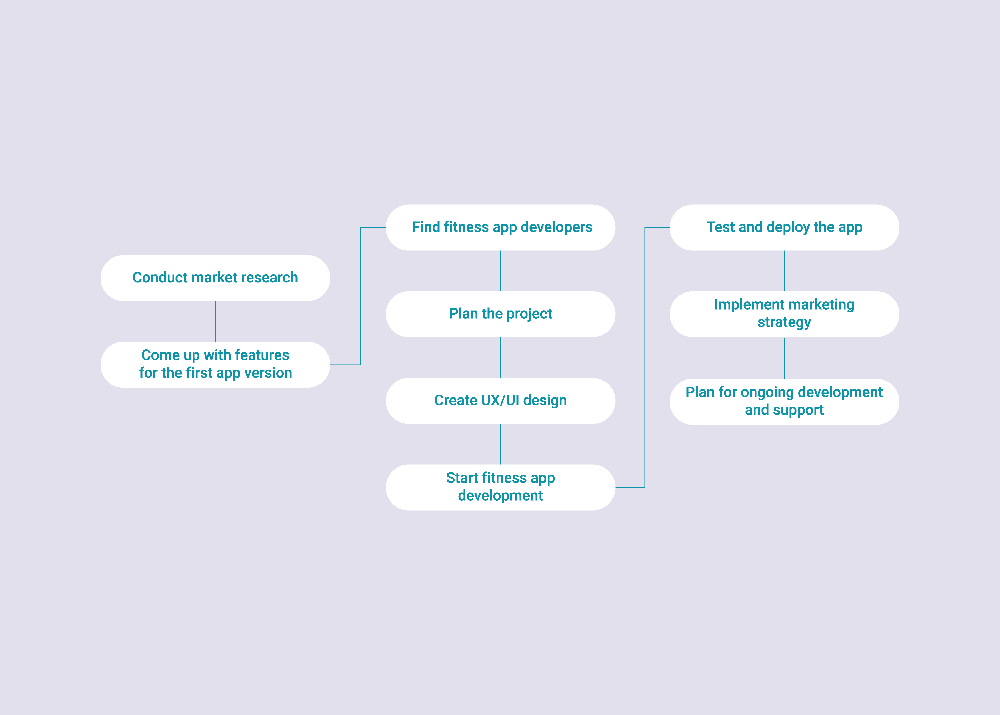How to Create a Workout App: Detailed Guide [Business & Tech]

Almost half (45%) of Americans have tried fitness tracking applications.
The development of such apps is a reasonable step since the market will continue to grow in the future. If you wonder how to create a workout app, you have come to the right place. In this article, we are going to overview the process to create a fitness app and cover the following topics:
- Custom workout app market state in 2024
- Types of fitness apps on the hype
- Basic and flagship features to build a fitness app
- How to create a fitness app and make money
- A step-by-step guide to creating a fitness app
- Fitness mobile apps development cost
It’s time to take a deeper look at each point. Let’s dive in!
What makes a fitness app successful?
The Global Fitness App Market was valued USD 3698.51 million in 2022 and is expected to expand at a CAGR of 30.63% during the forecast period, reaching USD 18374.13 million by 2028.
According to Statista, global online revenue generated by the fitness app market will reach 3,567.7 million U.S. dollars in 2024. Fitness wearables will generate a revenue of 17,863.9 million during the same period.
The demand for such applications will only continue to grow over the next few years, and investing in fitness app development is definitely a wise choice.
Fitness applications: Which are the most popular today.
The first step in deciding how to create a workout app is to determine which type of custom workout app you are going to build.
There are a few distinctive types of such applications that are the most popular today. Let’s take a look at each of them.
- Activity tracking apps
This type is the most popular among users. Such fitness tracking applications allow monitoring a user’s activity during the day. The application collects data on the number of steps taken, distance covered, the number of stairs climbed, speed run, hours slept and provides insight into the number of calories burned.
Activity trackers can be different, including running, cycling, and simple activity applications. Running and cycling apps often rely on GPS information to accurately track covered distances, determine speed, etc.
Such apps usually present information in graphs, enable users to save routes on the map, show users’ progress, and compare it with historical records.
A vivid example of such applications is Healthcare by Apple, which presents information in vivid charts.
- Dieting and nutrition apps
Almost 18% of female and 10% of male US users actively use applications to track their diet and nutrition. Depending on personal goals, users can rely on such applications to lose or gain weight, control their healthy eating habits, monitor the consumption of calories, and much more.
Examples of such applications are numerous and include such famous names as Lifesum, YouAte, Yummly, etc.
- Workout apps
If you wonder how to create a workout app, you are probably the most interested in this type of application. A workout application is like a personal trainer inside your smartphone. For the most part, such applications allow you to get personal training sessions in real-time with the coaches you choose.
In other cases, they allow users to create workout plans based on personal goals, preferences, physical conditions, etc. After users answer questions and provide information on their weight, height, and health conditions, they are presented with a workout plan.
Such names represent applications of this type as Fitbit Coach, Adidas Training and Running, Nike Training Club, and many others.

- High-intensity interval training apps
A similar app offers short training workouts that last for ~10 minutes. Because of high-intensity exercises, users spend a lot of energy and burn calories over a short time.
The first thing to remember if you want to know how to create a workout app is that such exercises require a certain level of user’s physical conditions. The information should be highlighted multiple times in the app. Plus, this criterion should be considered while developing the application.
Note: In your app, it is essential to mention that high-intensity training can be dangerous for some people, so it is better first to consult a doctor.
- Personal trainer or studio app
Some personal trainers and training studios have their own custom workout apps. You can build a fitness app of this type with different features. A possible set of functionalities can be very diverse, like features that allow you to choose a trainer, look up their schedules, find free time to book training sessions.
If you want to know how to create a workout app and make it successful, you might need to consider a news feed with helpful information. This feature will help with user engagement and retention.
- Meditation app
This type of fitness application is often called a yoga and meditation app. They provide users with different exercises that help them keep peace of mind and do yoga. It is important to remember that such practices should be divided into different levels of complexity based on users’ levels.
Great examples of such applications are Daily Yoga and the Breathe by Apple.

Features & Benefits for Fitness Application Development
Often, our clients ask our advice on how to create a workout app that users will fall in love with. The best way to achieve this goal is to include valuable features and unique ones for competitive advantage.
Let’s investigate the workout application features of the first type.

- Sign up / log in
User registration and sign in is a common functionality in a workout app. Make sure you provide users with different options, like registration with an email address and fast sign up with social media like Google, Facebook, Twitter, etc.
- User account
A user account is essential if you decide to create a fitness app to help you make money. Workout apps provide users with insight into their workout progress, achievement, personal goals, and much more.
You can include different options into a personal account, like the ability to use an app on multiple devices with the information stored in the cloud. Also, it is possible to add the functionality to manage paid subscriptions and billion information with integrated payment systems.
Among other options that users will enjoy is the ability to add their photos, adjust interface preferences, add their weight, height, and other physical and health conditions used to build personalized workout plans.
- Social integration
Nowadays, you can hardly find a user who is not active on a few social media platforms. As was already mentioned, you need to consider this feature when developing a workout app with a personal account. However, you can take this functionality a step further and, in addition to social sign up and log in, allow users to share their fitness results with their friends over social media.
- Device connectivity
We strongly recommend considering this feature if you decide to build a fitness app that will provide users with accurate and useful insight into their physical activity. Fitness app developers will help you integrate your personal workout app with different wearable devices. HealthKit and Google Fit APIs will help you derive data from Apple watch and the most popular wearables running on Wear OS by Google.
- Activity tracking
Activity tracking is the key feature in workout or any type of fitness app. This functionality is directly connected with the previous point as it entails the collection of information on user activity, which is best to do with wearables. However, it is also possible to use built-in smartphone sensors, like GPS.
You can build a fitness app that will count the number of steps made, calculate calories burned, miles covered, etc.
- Geolocation
Running and cycling fitness applications usually rely heavily on this feature. With the help of integrated Google or Apple maps and built-in GPS sensors, users can create routes for running, tacking, hiking, walking, etc. Strava has nailed this feature to perfection.
- Calorie counting
In most cases, people use workout apps to lose weight or put on muscles. Thus, it is important to count how many calories the users consume and burn on everyday tasks and during workouts.
- Notifications
Push notifications are a must-have for many applications, and fitness apps are not an exclusion. With such notifications, you can inform users about major updates inside your apps or remind them about planned workouts and the need to work out more.
Please remember that such notifications should not annoy users. For that purpose, it might be a good idea to allow users to adjust the app’s notification system by changing the time and frequency of such notifications
- Goal setting
Nothing motivates more than personal goals especially if you combine this feature with the ability to set personal goals and share them with friends over social media platforms. This is a great trick to push your users challenge themselves and motivate them to work out more and according to their personal plans. Don’t forget about this feature if you decide to build a workout plan app.
- Workouts
There are different ways to implement this feature when creating a fitness app. You can provide users with standard workouts, allow to create personal ones by themselves, or get professional consultation and workout plan creation by a professional fitness coach.
- Settings
Users love settings and customization. Whether they want to turn on push notifications, reminders or mute all of them, they need to a have that freedom. Give users an option to make minor changes to the interface (like white and dark themes), configure notifications, and set up other parameters.
- Educational content
The best approach to have user retention is to educate your users about a healthy lifestyle, workouts, diets, and other topics that might interest them. You can share valuable content in different forms, e.g., checklists on how to be fit, videos with the best workout exercises, etc.
The above features show how to create a workout app of the simplest type. Read on to find out how to make a fitness app that will offer unique functionality.
What flagship features should a fitness app have?

Let’s help your application stand out among competitors with the help of unique fitness app features.
- Gamification
Gamification is the new normal to develop a user-friendly and attractive application. Implementing such functionality helps users stay motivated and interact with your application more.
You can allow users to compete with friends, create a reward system with badges, start contests, etc. RunKeeper and Nike+ are two solutions for inspiration if you decide to build a fitness app with such features. Take it even further and allow to exchange the received points for paid functions, access to unique content, or partner with some sports clothing and equipment store to exchange points for actual products. Or you can send your own branded presents to customers for big in-app achievements.
- Virtual reality
Don’t just create a fitness app but turn it into a real game with virtual reality. The feature should be positioned as a unique and flagship one, as it can become your competitive advantage. Be aware that the implementation into fitness app development is an extensive process that requires additional expenses. Go for this feature only if you have some unique and valuable ideas.
- Voice control
If you want to create a workout app with superior user-friendliness, consider adding such functionality. It can benefit applications of all types, as users can pause their training, change exercises, set up timers with their voice.
If you decide to go on with such functionality, fitness app developers can implement it with Google Assistant for Android devices and Siri for iOS.
Note: The number of features will directly influence the budget and development timeline. Thus, it might be reasonable to start with developing fitness with a basic set of features and add additional ones with further iterations after you have successfully tested the first version of your workout and diet app.
Custom Workout App Monetization Strategy
You can make money with your workout app by choosing one of the following business models:
- Paid
- Freemium
- Ads
- In-app purchases
- Sponsored content
Let’s examine each option in more detail.
- Paid apps
Users have to pay for fitness applications before using fitness applications of this type. It is possible to create a paid app with a one-time payment or provide subscriptions. The price you set can vary based on the locations, set of features, etc. Use this business model only if you know how to build a fitness app with unique features.
- Freemium
This is another popular business model, as it allows users to test basic functionality before they have to pay for something. You need to be prepared that basic features will be enough for some users. Still, you can entice them to pay for additional content, features, workouts, or personal coaching and nutrition services.
- Ads
In-app ads are still one of the most popular business models. Aside from getting money for ads placement, you can also provide users with an option to block all advertisements for some payment.
- In-app purchases
Even if you choose one of the above approaches, you can include this feature additionally. You can always offer users some content for payment, like workout checklists, tips, personal training sessions, consultations, and much more.
- Sponsored content
This business model requires dedication and the desire to find partners among other sports companies. You can allow them to place ads of their businesses inside your app, offer unique content, and sell their expertise. Such apps are a win-win, as you get money while your users get unique content for a small payment.
How to Create a Workout App: Step-by-Step Guide

It is time to move to the step-by-step guide on how to create a workout app. You will learn the main steps and stages of the mobile fitness app development process.
Step 1: Market Research
During this stage, you need to study the local fitness applications market and decide which fitness app you want to create. Before you move forward and start the development process, you need to reveal your competitors, their strengths and weaknesses, and how they solve user points. Use the collected data to make a comprehensive analysis and decide which type you want to create.
Step 2: Features for the First App Version
It is time to decide on features to create a fitness app that will be user-friendly and feature-rich. Create a full list of features for the version of your workout application and identify which ones will help you be better than competitors.
Step 3: Find Fitness App Developers
Approach this stage with attention and be ready to spend quite some time finding the most reliable vendor. As you will review companies, pay attention to the following factors:
- number of years on the market
- relevant experience in mobile app development
- positive customer feedback
- favorable time zone and hourly rate
- availability of senior developers
You can look for development companies on Clutch, Manifest, ITFirms, and other similar directories where you can compare hourly rates, check reviews and find a company that will become your reliable technical partners for the duration of your project.
Step 4: Mobile Workout App Development
In most companies, the development process is divided into five big stages:
- Analysis and planning – this stage, also called the Discovery stage, usually entails the cooperation of business analysts, UX/UI designers, software architects, and product owners. During the discovery stage, you analyze the market, choose the best approaches to app development to create app architecture, and design the prototype.
- UX/UI design – during this stage, designers create user flows, define the best ways for users to interact with your application, design the app’s user interface, and create branding elements.
- Fitness app development – that is where the development process starts. During this phase, developers implement all the planned features and create the needed software architecture.
- Testing and deployment – this step ensures that your application doesn’t have any bugs and users will not have problems interacting with it. After the app is tested, you can release it to the market.
Step 5: Marketing Strategy
You should start working on your marketing strategy even when your application is still in the development stage. You can use a complex approach and promote your app through different channels:
- paid ads (Google, Facebook, in-store)
- social media marketing
- integration with niche influencers
- app advertising at events
- cooperation with fitness companies
After successfully launching the app, keep track of the critical metrics to understand what you can improve in your application with future versions.
Step 6: Ongoing Development and Support
After you create a list of improvements, continue working on your application. Improve its functionality, add new features, listen to customer feedback, and address their pain points and actionable solutions.
The above explains how to create a workout app and guarantee its success.
How Much Does It Cost to Make a Fitness App?
A fitness app usually costs $5,000-$10,000. You will need to pay $38,000-$172,000 for a medium app and $172,000+ for an extensive application with versions for separate operating systems.
Please note that the above estimation is very rough. The final cost depends on the number of features, supported operating processes, app architecture, country to which you outsource app development, etc.
How to Create a Fitness App: Key Takeaways
Once you decide to create a fitness app, you will need to deal with market research, app creation planning, development process, after-launch support, and ongoing development. You can ensure the success of your future application by choosing a unique set of features and solving the problems that your competitors failed to do.
You can start with the first version of an application for iOS or Android to test your idea. Such an application should have basic features and provide users with a general app idea. If your idea turns out to be a hit, continue the development process, and invest in adding more advanced features.
Various Workout Applications, Apps for Fitness, Mobile Healthcare, Lifestyle Trackers and Their Benefits, Mobile Monetization, Medicine Delivery App, Free Apps, Product Development Life Cycle, AI in App Development, Shopping App Development, Augmented Reality, Promote Brands, Mobile Apps Developer, Medicine Delivery App
Develop Your Workout App
Elevate fitness routines with your own workout app
Our Expertise Covers:
✅ Customized workout plans and exercise routines
✅ Progress tracking and performance analytics
✅ Integration with wearables for enhanced user experience
Table of contents
FAQ
The minimum cost of fitness app development is $5,000-$0,000 for the simplest app version with minimum features. The cost can reach up to $172,000 and go beyond if you decide to create two feature-rich native apps for iOS and Android.
The Global Fitness App Market was valued at 13,78 billion in 2021. From 2021 to 2030, it is predicted to grow at a CAGR of 24,3%. In 2024, the global workout app market will be estimated at $120.37 billion.
To make money with your fitness application, you can choose one of the following business models:
- Paid app
- Freemium model
- In-app ads
- In-app purchases
- Sponsored content
 TOP 8 trip planning apps 2024: Best trip organizers for you
TOP 8 trip planning apps 2024: Best trip organizers for you
 How Much Does It Cost To Build An App For your business In 2024
How Much Does It Cost To Build An App For your business In 2024
 How To Create A Dating App: From Concept To Successful App
How To Create A Dating App: From Concept To Successful App